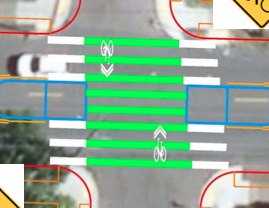
like this one in concept stage for
SE 53rd and Stark.
Crosswalks are standard engineering treatments designed to help people get across streets with a bit more safety; now the City of Portland is looking to do something similar for bike traffic with bicycle crosswalk markings, a.k.a. the “cross-bike”.
The concept itself has been floating around PBOT since about 2007, but the idea has yet to gain real traction. The other night, while looking over plans for an upcoming road project, I was surprised to see them as prominent features. Turns out that PBOT hasn’t forgotten about them.
PBOT bicycle coordinator Roger Geller shared a bit more about bicycle crosswalks via email today. Check out the Q & A below for more…
What are “cross-bikes”?
Think about them as a crosswalk for people riding bicycles. We identified the “cross-bike” as a possible simple crossing treatment for neighborhood greenways at relatively low-volume collector streets [larger than residential streets but smaller than major arterials]. It would consist of a distinctive marking on the roadway (yet to be determined), either as a stand-alone treatment or in conjunction with some other crossing treatment, like a median refuge or curb extensions. Crosswalk markings would also be a standard design element.

Could also be used at off-set intersections.
|

Another example
|
Q. How did the concept come about?
A. The idea for the cross-bike emerged from observations that one unintended consequence of building curb extensions as crossing treatments on neighborhood greenways was that motorists on the collector street would occasionally stop and yield the right of way to a cyclist waiting to cross [even when the motor vehicle operator had no legal obligation to do so]. Though that was not the intent of the curb extensions (which were intended mostly to shorten the crossing distance and thus allow cyclists to take advantage of shorter gaps in cross traffic, while improving sight distances and visibiity), we considered it a positive benefit and began to consider ways to reinforce these locations as crossings for cyclists. We landed on the idea of providing a prominent marking to further alert motorists to the presence of crossing cyclists.
Q. Where does Portland stand in actually putting these out on the street?
A. We are in the process of developing such a marking. Cross bikes are being seriously considered for the 50s bikeway project as an initial full-scale test of the concept.
Q. Since the markings aren’t compliant with federal standards, how will you proceed?
A. That’s right, these markings are not MUTCD [Manual of Uniform Traffic Control Devices, the federal guidebook for all traffic markings and signs] compliant so we would not be able to use them on a federally funded project (such as the 50s) unless we requested and were granted experimental approval by FHWA, so we’re currently discussing how to proceed. One way to proceed might be to use a design that makes extensive use of the shared lane marking as that may stand a better chance of gaining quick acceptance at the national level, though ultimately we want to use a design that we feel will best accomplish the operational goals.
In implementing this treatment we intend to work with PSU and the IBPI [Institute for Bicycle and Pedestrian Innovation] to evaluate their effectiveness. If it seems a worthy concept, we would then consider future legislative action to codify that motorists are to treat the cross bike for cyclists in the same manner they must treat cross walks for pedestrians.
Q. Are any other U.S. cities using this type of marking?
A. No, we are not aware of any other U.S. city using them for this purpose. However, there are decorative trail crossing treatments that are used in some communities that likely have a similar effect. We are aware of at least one intersection in The Netherlands that uses such a treatment. At that location the entire intersection is painted completely yellow. [See photo below provided by Geller]

(Photo: Denver Igarta)
I hope PBOT finds a location to test out these markings. As they did with blue bike lanes and bike boxes, this is another example where PBOT is showing a willingness to experiment with new concepts that make bicycling safer and more attractive to people of all skill levels. It will be interesting to see how they work out in the wild.
UPDATE: For a more detailed look at these and other markings, see this PBOT PDF from back in 2007 titled, Enhanced Bicycle Boulevard Markings Demonstration Project.

